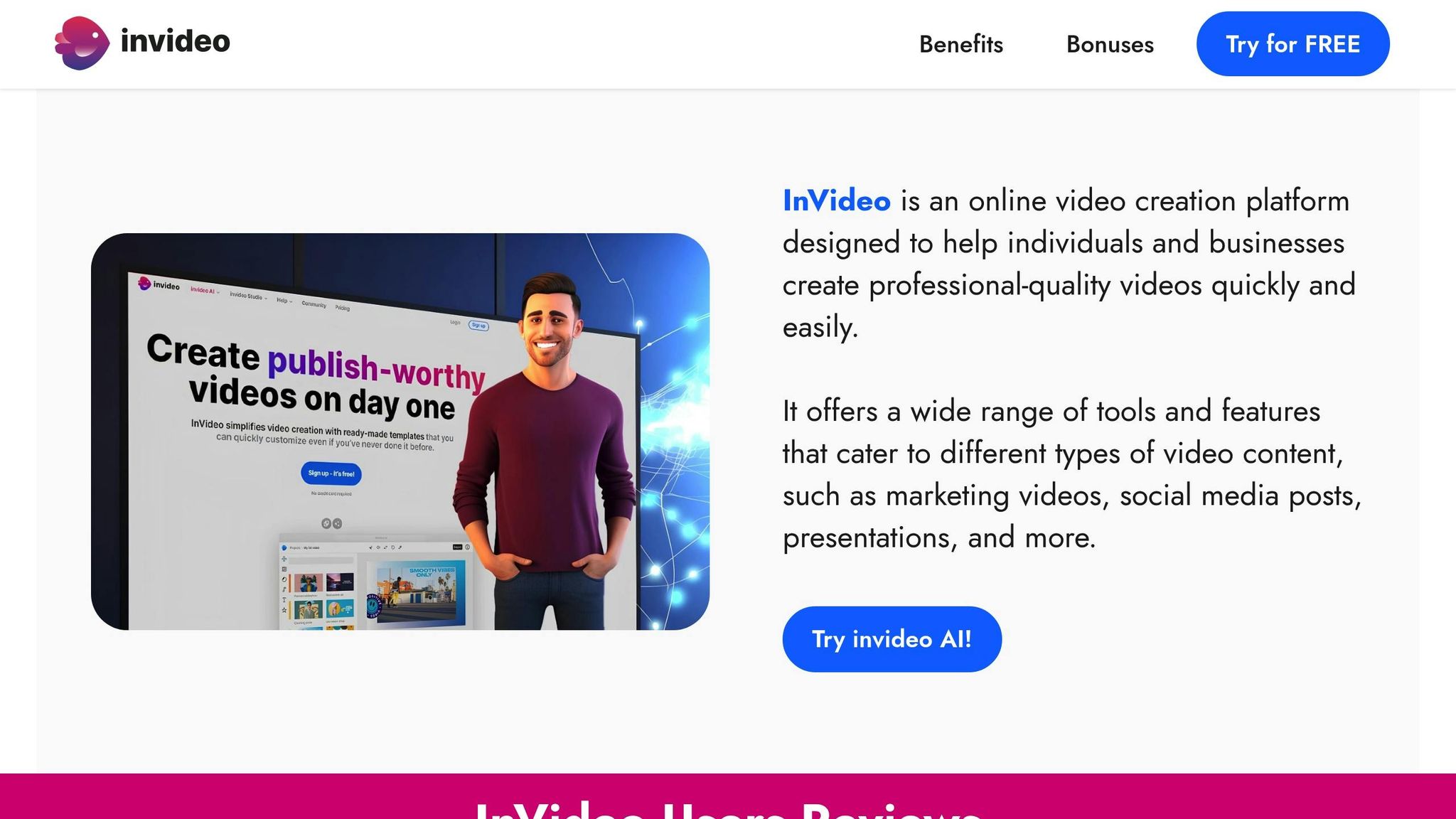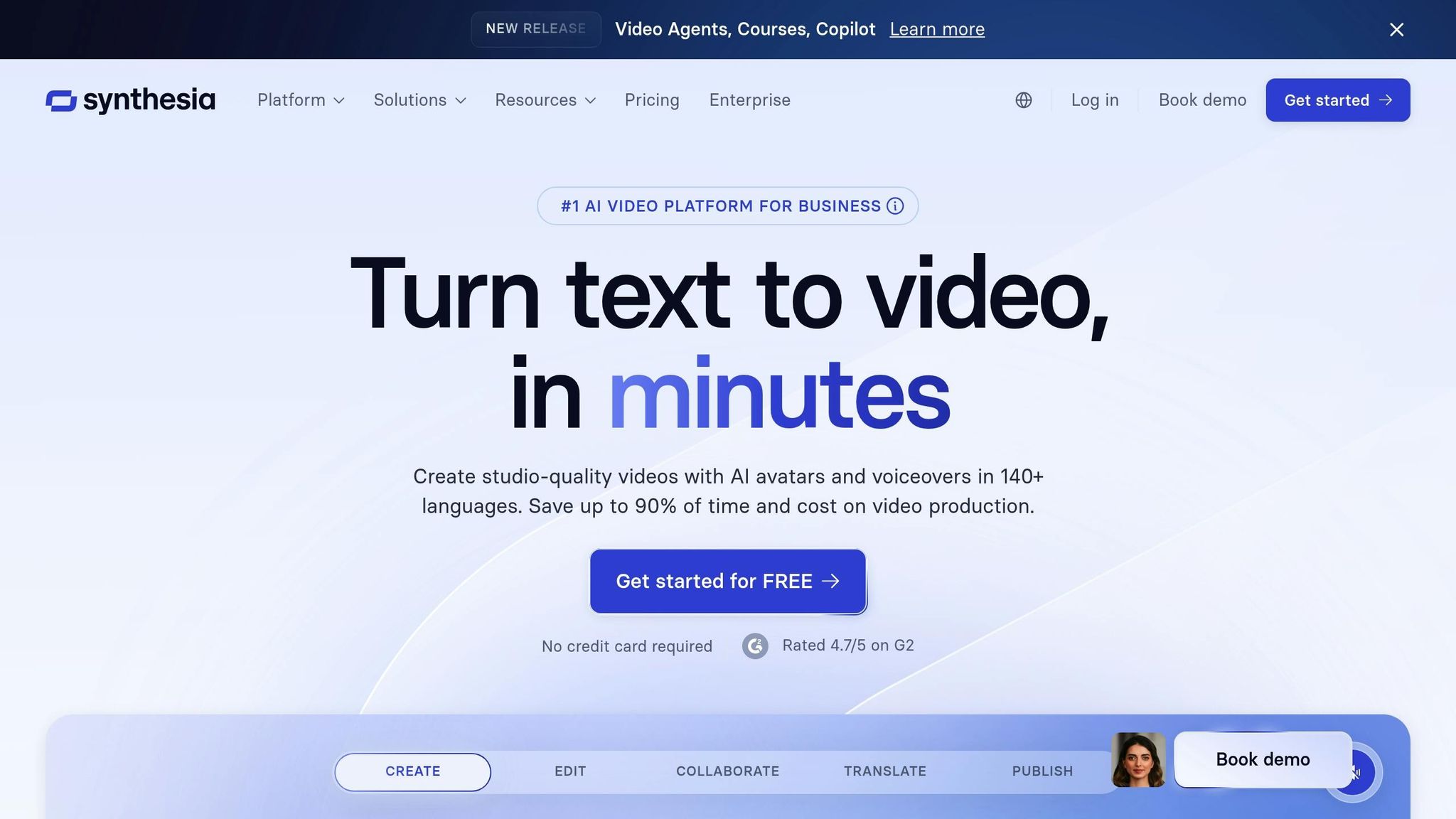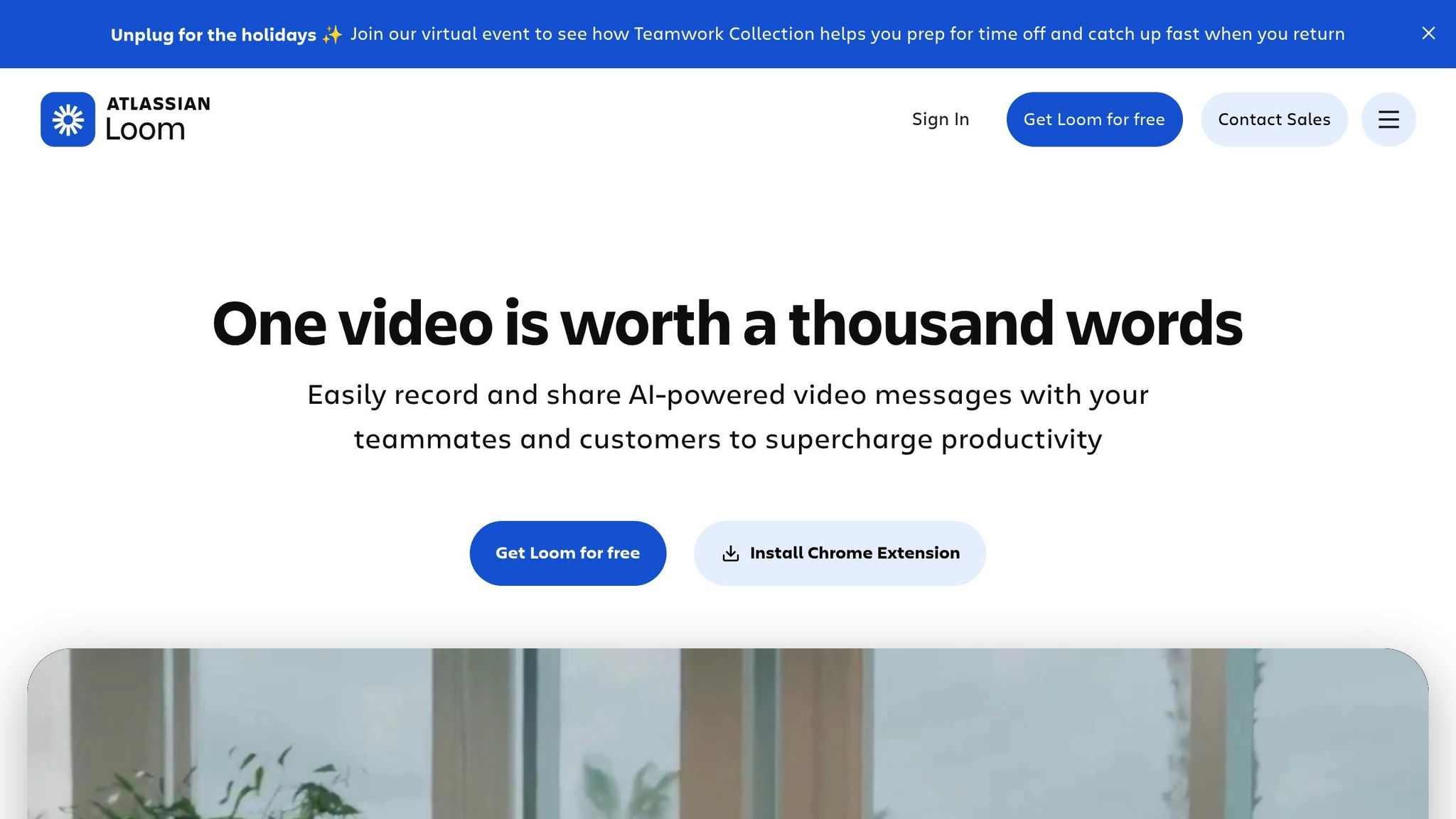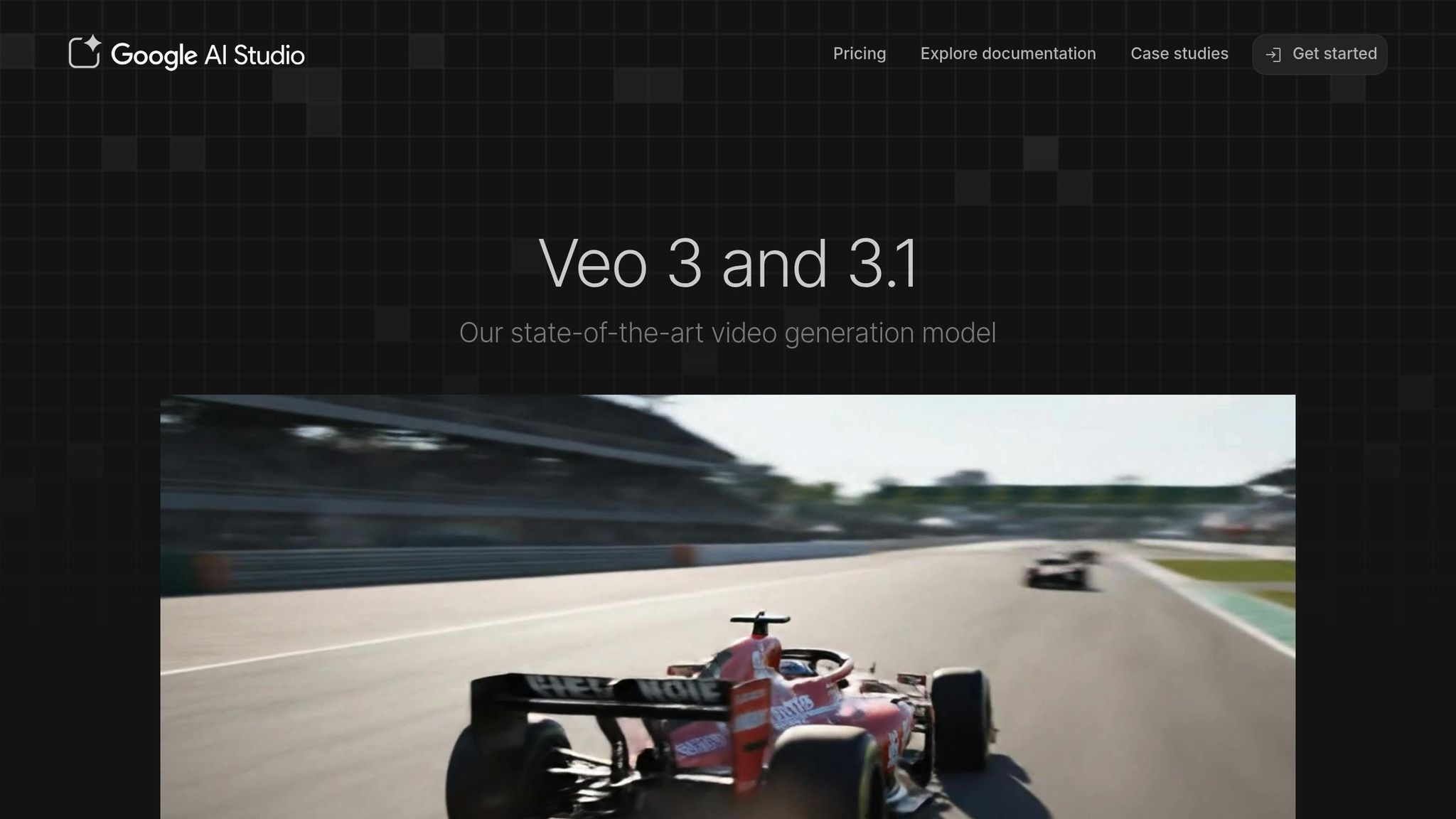AI-powered text-to-video tools have become essential for creating high-quality videos without the need for filming. By converting text into videos, these platforms are helping creators, marketers, and businesses save time and reduce costs. Whether you’re producing social media content, training videos, or advertisements, these tools offer features like AI avatars, voiceovers, multilingual support, and customizable templates.
Here are the top six text-to-video tools in 2025:
- InVideo: Ideal for marketers, it offers polished templates, voice cloning, and multilingual support. Pricing starts at $0 (free plan) with advanced features at $96/month.
- Synthesia: Known for lifelike AI avatars, it’s great for corporate training and global marketing. Custom avatars and multilingual options are key highlights.
- Loom: Focuses on business communication and screen recording. Simple and affordable, starting at $10-$15 per user/month.
- Lumen5: Best for repurposing blog posts into videos. Offers templates and stock media, with plans from $19/month.
- Google Veo: Uses text prompts to generate videos with advanced customization. Free tier available; credits-based pricing for advanced features.
- Pictory: Converts long-form content into short videos for social media. Simplifies video creation for marketing teams.
Quick Comparison
| Tool | Best For | Key Features | Starting Price |
|---|---|---|---|
| InVideo | Marketing videos | Templates, voice cloning | Free, $28/month |
| Synthesia | Corporate training, marketing | AI avatars, multilingual | Subscription-based |
| Loom | Business communication | Screen recording, simplicity | $10-$15/month |
| Lumen5 | Social media content | Blog-to-video, stock media | $19/month |
| Google Veo | Advanced customization | Text prompts, flexible design | Free/credit-based |
| Pictory | Social media marketing | Short-form video creation | Subscription-based |
Choose based on your needs: Loom and Lumen5 are affordable and simple, while Synthesia and InVideo offer advanced features for professional use. Google Veo and Pictory cater to unique requirements like high customization or repurposing content.
5 Best AI Video Generators in 2025 (Most Realistic Tools Yet!)
1. InVideo

InVideo transforms scripts into polished videos with the help of AI-generated voiceovers, making video creation more accessible and efficient for users.
Video Quality and Templates
InVideo is known for producing high-quality videos tailored for social media, explainer content, and promotional campaigns. Its intuitive interface ensures that users can craft professional-looking videos with ease, even without prior expertise.
Voice and Language Features
The platform offers a range of voice and language options. Users can choose from different accents or even clone their voice to maintain brand consistency. Additionally, its multilingual support enables instant translations with a single command, catering to global audiences. These features are available through a tiered pricing system, accommodating everyone from solo creators to large enterprises.
Pricing Breakdown
InVideo’s pricing plans are designed to fit various needs, offering flexibility for creators and businesses alike:
| Plan | Monthly Cost (Annual Billing) | Voice Clones | Key Features |
|---|---|---|---|
| Free | $0 | 0 | Basic features, no voice cloning |
| Plus | $28 | 2 | Standard features, including voice cloning |
| Max | $48 | Multiple | Advanced features and additional voice clones |
| Generative | $96 | Not specified | Includes 15 minutes of generative credits |
For users with higher demands, scalable options are available. For instance, enterprise users requiring 270 minutes of generative credit, 2,000 AI minutes, and 3,200 iStock images would pay $1,920 per month.
Recognized as the "Best For Text-To-Video Generation", InVideo excels at turning written content into engaging video formats. This makes it a go-to choice for marketers and content creators looking for efficiency and polished results.
2. Synthesia

Synthesia simplifies video production by using AI-generated avatars to deliver your text, making it an excellent tool for corporate training, marketing, and educational purposes.
AI Avatar Technology and Video Quality
Synthesia's platform features a variety of AI avatars that deliver natural speech and lifelike gestures, making videos more engaging and relatable. For businesses looking to maintain a consistent brand image, the platform also allows users to create custom avatars based on their own recordings, ensuring a personalized touch across all projects.
Language and Voice Options
The platform supports multiple languages and accents through its text-to-speech functionality, making it ideal for organizations with global audiences. Users can adjust speech speed and add pauses, which is particularly handy for creating effective training materials and marketing campaigns.
Templates and Customization
Synthesia offers a library of templates tailored to common business needs, such as product demos, training sessions, and presentations. These templates come with pre-designed layouts and animations, which can be customized with your brand's elements. This setup not only saves time but also ensures professional-quality results that align with your brand identity.
Pricing Plans
Synthesia provides flexible pricing options to suit different needs, from individual content creators to large enterprises. With both subscription-based and usage-based models, there's a plan for everyone - whether you need occasional videos or frequent production.
Synthesia stands out for its ease of use and high-quality avatar-driven video content, making it a valuable tool for businesses looking to modernize their video production processes.
3. Loom

Loom is all about business communication and screen recording, turning written scripts into practical video content. With its AI-powered tools, it simplifies the process of creating polished videos, making it a go-to for teams looking to streamline communication.
Video Quality and Recording Features
Loom delivers HD video recording up to 1080p, ensuring sharp, professional visuals for presentations and tutorials. It also optimizes video compression, so sharing is quick and seamless without losing clarity. This makes it a great fit for teams needing to distribute content across various devices and internet speeds.
What sets Loom apart are its AI-driven features like automatic background noise reduction and smart cropping, which centers the most important parts of your video. These tools are a lifesaver for remote teams or anyone recording in less-than-ideal conditions, helping create polished results with minimal effort.
Voice and Language Capabilities
Loom supports real-time voice recording and enhances audio during post-production with AI. While its multilingual support is basic, it excels in producing clear, natural-sounding narration for English-speaking users.
Recent updates include smarter voice transcription and automatic summarization, which extract key points from lengthy videos. Though it doesn’t offer advanced features like voice cloning or extensive accent options, Loom focuses on being user-friendly and accessible for everyday business needs.
Template Options and Customization
Loom offers templates tailored for common business tasks like onboarding videos, product demos, and status updates. These templates can be customized with branded colors, logos, and layout tweaks, though the library is more focused compared to full-scale video production tools.
The emphasis here is on simplicity and speed. You can quickly adjust layouts without needing advanced editing skills, making it a great choice for teams aiming for consistent, professional-looking videos without a steep learning curve.
Pricing Plans
Loom has a free tier for basic video creation and sharing. Paid plans start at about $10-$15 per user per month, offering more features, higher video limits, and integrations that benefit workplace collaboration.
For larger teams, Enterprise plans come with bulk discounts and extra security features like SOC 2 compliance and advanced user management. This pricing model makes Loom a practical choice for teams that value efficiency and collaboration over high-end video production.
Loom shines by focusing on human-recorded content enhanced with AI tools, making it a standout option for teams prioritizing clear, effective communication over cinematic production.
4. Lumen5

Lumen5 is designed to turn written content into engaging videos, making it a go-to tool for repurposing blog posts and articles into social media-friendly formats. Instead of building visuals entirely from scratch, it works as a smart assistant that analyzes your text and crafts videos using templates and a vast library of stock media.
Video Generation Quality and Features
Lumen5 takes a practical approach to video creation. It automatically processes your text, recommends relevant stock footage or images, and overlays text onto pre-designed templates. These templates are tailored for various platforms like LinkedIn, Facebook, and Instagram, ensuring your videos have the right aspect ratios and styles for each.
The free plan delivers 720p resolution, includes automated captions, and comes with watermarked videos and a cap on monthly exports. To unlock higher resolutions, remove watermarks, and gain more flexibility, users can opt for paid plans. These features make Lumen5 an excellent choice for businesses aiming to produce polished content for social media marketing.
One standout feature is its ability to transform a blog post URL into video segments instantly, which significantly speeds up the video creation process for content teams.
Voiceover Capabilities
Lumen5 also offers AI-powered text-to-speech tools that add professional narration to videos. While its voice options are less varied compared to specialized voiceover software, the audio quality is clear and natural, making it a solid choice for business and educational content.
Voiceovers are seamlessly integrated into the video creation process. The platform automatically syncs narration with visual elements and text overlays, ensuring that even users with no prior experience can produce videos with smooth and consistent narration.
Template Library and Customization
In addition to voiceovers, Lumen5 shines with its well-developed template system and extensive stock media collection. Users can tweak colors, fonts, and branding elements to ensure their videos align with their brand identity, making it a versatile tool for teams producing regular social media content.
Riveron from Veo3 AI shared, "Strong template and stock media libraries simplify creation".
The platform’s templates are designed for ease of use, guiding users from text input to video export with minimal effort. This streamlined workflow is especially helpful for teams without dedicated video editing expertise.
With its customization options and straightforward interface, Lumen5 is an appealing choice for content teams seeking efficiency.
Pricing Plans
Paid plans start at $19 per month, offering additional features like higher resolutions and watermark-free videos. This pricing is ideal for small businesses and marketers who need frequent video output without the complexity of advanced editing software. For larger teams managing multiple brands, enterprise options provide enhanced capabilities.
Still, as Riveron from Veo3 AI points out, "The output can feel formulaic compared to true generative AI models". While Lumen5 prioritizes speed and consistency over cinematic production, it’s a perfect fit for marketers and bloggers focused on repurposing content efficiently rather than creating highly original visuals.
sbb-itb-212c9ea
5. Google Veo

Google Veo stands out among text-to-video tools thanks to its innovative, prompt-driven approach. By leveraging advanced machine learning, it transforms text prompts into videos, enabling creators to shape both style and content with precision. This makes it a powerful tool for producing high-quality, customizable videos.
Video Generation Quality and Features
Veo excels at turning text prompts into seamless video sequences. It ensures smooth scene transitions and offers options for customizing camera movements, giving creators more control over the final product.
Language and Voice Support
With support for multiple languages, Google Veo makes text input accessible to a global audience. It also features text-to-speech capabilities, delivering natural-sounding narration. Users can further personalize their projects by uploading custom audio or recording their own voiceovers.
Template Availability and Customization
Rather than relying on rigid templates, Veo provides style examples and prompt resources to guide users. This flexibility allows for iterative adjustments, so creators can refine their videos without starting over from scratch.
Pricing Model
Google Veo operates on a credit-based pricing system. It offers a free tier, subscription plans, and enterprise options. Pricing depends on factors such as video resolution, duration, and feature usage, reflecting the platform's advanced functionality.
6. Pictory

Pictory takes a creative approach to content creation by focusing on turning lengthy materials into bite-sized, attention-grabbing videos. Whether it’s blog posts, articles, scripts, webinars, or even podcasts, Pictory simplifies the process of repurposing content for social media and marketing.
The platform automatically scans your content, identifies key points, and pairs them with visuals from a licensed stock library. The result? Short, polished videos that are tailored for online audiences and marketing campaigns.
Pros and Cons
After diving into the features of each tool, let’s break down their strengths and weaknesses to help you decide which one fits your needs.
InVideo stands out with its rich customization options and a vast library of templates, making it a go-to for branded content. That said, its interface can be tricky for beginners to navigate, and the free version includes watermarks, which might not work for professional use.
Synthesia shines with its lifelike AI avatars and strong multilingual support, making it perfect for corporate training or global marketing campaigns. However, its higher price point might be a hurdle for smaller teams or tighter budgets.
Loom offers a smooth, user-friendly experience for screen recordings and quick video messages, making it ideal for internal communications and tutorials. But its simplicity means it lacks the advanced editing tools needed for more complex marketing videos.
Lumen5 transforms written content into engaging videos using AI-powered content analysis. Its drag-and-drop interface makes it easy to use, but some key features are locked behind higher-tier plans, which could be limiting.
Google Veo uses advanced AI and integrates seamlessly with other Google services, delivering high-quality results. However, since it’s still in early access, its features and availability are subject to change.
Pictory is great for turning long-form content into bite-sized, shareable videos by highlighting key points and pairing them with visuals. While this boosts productivity, it can sometimes oversimplify topics that require more depth.
When choosing, consider factors like customization, ease of use, pricing, and any potential limitations each tool may have.
Conclusion
When selecting a text-to-video AI tool, consider your specific needs and budget. InVideo stands out with its extensive customization options but may require more time to master. Synthesia offers realistic AI avatars and multilingual support, making it a premium choice for polished productions. For internal communication, Loom provides quick and efficient solutions, while Lumen5 simplifies the process of repurposing content. Google Veo brings cutting-edge AI features but is currently limited to early access, and Pictory shines in converting long-form content into engaging social media clips.
If you're working with a smaller team, affordable options like Loom and Lumen5 might be the perfect fit. On the other hand, larger enterprises looking for advanced capabilities may benefit from premium platforms such as Synthesia and InVideo. For detailed specifications and feature breakdowns, refer to the reviews above and choose the tool that aligns with your video production goals.
The world of text-to-video AI is constantly changing. This overview serves as a quick guide alongside our in-depth comparisons, helping you find the right tool for your needs. If you're eager to stay updated on the latest advancements or explore emerging solutions, AI Apps offers a directory featuring over 1,000 AI tools across various categories. Their regularly updated listings can help you discover new platforms that may better suit your evolving requirements.
Take advantage of free trials and keep an eye on AI Apps' directory to stay ahead in the ever-evolving video production landscape.
FAQs
How do AI text-to-video tools improve corporate training and marketing video production?
AI text-to-video tools simplify the process of creating polished videos by turning written content into dynamic visuals. This means businesses can produce training materials, onboarding videos, or marketing content without needing cameras, actors, or expert editing skills.
By automating key steps in video creation, these tools help save both time and resources while delivering high-quality results. They're particularly handy for teams aiming to ramp up video production or tailor content for various audiences, all while keeping workflows efficient.
What should I look for when choosing the best AI tool for creating social media videos?
When picking an AI tool for creating social media videos, it’s important to keep a few essential factors in mind to make sure it suits your needs. Start by assessing its user-friendliness - especially if you’re new to video creation. Tools that offer features like customizable templates, text-to-video options, and built-in media libraries can make the process much smoother and save you time.
Another key consideration is pricing. Check if the tool fits within your budget while offering a good balance of features for the cost. Lastly, think about your specific goals, whether it’s producing eye-catching ads, educational tutorials, or polished branded content. Choose a tool that aligns with both your creative vision and business needs.
What is Google Veo’s credit-based pricing system, and how can users plan their video production budget effectively?
Google Veo uses a credit-based pricing system, where you buy credits to create videos. Each credit corresponds to the features you choose or the video's length and complexity. The exact cost of credits and how many you'll need depends on the plan you select.
To budget effectively, think about how many videos you plan to make, the features you'll require, and the typical credit usage for those features. This approach will give you a clearer idea of your total costs and help you avoid surprises. If you're working on larger projects, purchasing bulk credit packages might be a more cost-efficient option.



